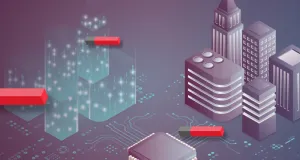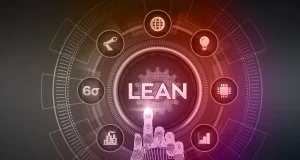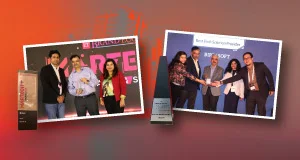A big hello and a warm welcome to the second episode of Tech Lyceum, a podcast series from Birlasoft coming from the BMarc manufacturing series. Now this time around, we're going to be unpacking how digital twins are revolutionizing plants of the future, and to give us some very valuable insights, we've got not one but two guests on the show today. First up, we have our very own Paul Menig back again, thought leader and a Senior Principal Consultant at Birlasoft manufacturing BBU. His experience across various industries, including manufacturing, medical, defense, aerospace and transportation, truly make him an unstoppable force in this field. Also joining us today is Shamdutt Kamble, the Global Practice director digital manufacturing at Birlasoft, and Sham has got nearly 30 years of experience in the bag, in Smart Manufacturing, digital twins, industrial analytics, and he's the perfect addition to this podcast to give us a precise speak into this world, gentlemen, welcome to the show today.

Thanks very much for having me again. I look forward to talking with everybody.
Hey, hi everybody. This shamdutt, I'm happy to be part of these discussions and looking forward for more interesting discussion around digital twins.
Absolutely. We're very thrilled to have both of you on the show now. First question coming at you. Paul manufacturers currently have all these different definitions of digital twins right within their organization. Some think it's a simulation software. Others believe it's a visualization tool, or it's a technology meant for predictive maintenance, and there are many other definitions. But in your view and experience,
Q: What would you say are digital twins? And how is it digitally transforming the manufacturing plants?
So the one thing that I didn't hear you mentioned is model, and a digital twin is a model. It's a highly accurate, real time computer software model. It's interconnected with the physical world, and it's continuously updated based on inputs from sensors in the real world. That kind of a model requires a multitude of ways to watch, measure, assess and predict what a machine, a factory or a transportation system, will do under both predictable and adverse conditions. Now, getting to that kind of a virtual physical model requires many of the technologies that have been developed over the past decades, such as artificial intelligence, machine learning, augmented and virtual reality, the industrial internet of things, both high speed and wireless communications, edge computing and much More. Such models are used for complex products like aircraft engines, manufacturing production lines, large processing plants and warehouse operations, many models like this allow us to envision an intermediate variable that we cannot physically see or measure, such as a specific stress in the crankshaft of an engine, or the wobble of a shaft in a CNC machine, if we have a well designed and implemented digital twin model that allows us to run through a multitude of scenarios in the digital world to both understand and predict in advance, what could go wrong now, if we run those scenarios through the digital twin during the design of the part, the tooling and the software of the machine, we may be able to prevent that bad part, and from my experience, that can save millions of dollars and human lives.
Sounds like a very important role, and thanks for clearing that up and giving us an accurate way of thinking about digital twins. And that brings me to this question to you, Sham, as we know, every technology comes with its own set of challenges, and you know that's no different when it comes to digital twins.
Q: So in your opinion, what are the specific challenges manufacturers deal with, and how do you think they can overcome these challenges?
As Paul mentioned, right. What is the detail to in and what technologies and what systems goes into it? And definitely so once the end user overcomes this basic, foundational IT OT integrational challenges, the next level of challenge. What they start seeing is they want to move into the next level of digital maturity, or digital transformation. Maturity is like, what is my starting point? Where should I start? How can I prioritize of building the digital twin, whether it should be, you know, the digital twin of assets. Or process or product daily twin. How do you start okay? So just to share with some of the experience, what we have with our customers, we have been working with the automotive customers, the process manufacturers, the med devices. So the starting point really depends upon like, what is your key burning issues? Where do you want to really fix those which are directly, you know, impacting your business KPIs and metrics, or operational KPIs and metrics, like, for example, the automotive customer we were not talking to we were working with, they had issues around the productivity and the throughput, whereas the web device customers had, how can I accelerate my new product initiative cycles so that I can bring my product faster to market. How can I improve more on the quality, so that I have the customer satisfaction? So all this, we know, look into as a key points to start as and then see how can we align? And I'm sure most of these manufacturers do have the larger initiatives, either around the operational excellence or zero defect, or the, you know, TPM’s. So we align to those initiative. We don't want to know change the direction what the end user has taken, align those and see what would be the good starting point, so that they start seeing the immediate impact. They start seeing that their alignment into the issue initiatives they have taken. Okay? So, having said that, then the next level challenge, they come out click to build a digital twin, and how they are placed, in terms of their IT OT systems, in the maturity, in terms of the readiness, the scalability, what kind of data they have today? What are the gaps in the data? What that basically leading to the data qualities, if at all, we have to build the model around this as a little twin. What would be the accuracy of this with a given set of thing? What more we have to do? Of course, cyber security remains the key issues. Many of this, and it will continue to remain so, like most of the customers are very uncomfortable in terms of saying, okay, whether my data is getting out of my factory, out of my enterprise, how are you going to protect so those things has to be taken care of. And more important is the change management. So change management in terms of the way of working, right the currently with the IT or OT systems, the personals or operators or supervisors are working. So there will be definitely change in the processes, change in the governance model, so that has to be also taken care of. So with all these challenges, no if we do right fit gap analysis and execute the best practices, depending on the years of experience around these technologies, and we definitely help evolving around the right Enterprise Architect blueprint, which will address most of these issues upfront.
I hope these challenges can be soon overcome. You know, because the impact of digital twins sounds like it holds more power than the resistance. So that's the hope of the future. Well, coming to you Paul, the roadmap for digital twins is something we're going to be addressing now Q: What, according to you, is the right time and purpose manufacturers should consider so that they can start looking to build and implement digital twins and systems and processes.
Thank you for that question. And when you say roadmap, I immediately think of planning for a trip in getting all of the essentials together that we'll need. In this case, we're talking about the essential IT infrastructure for getting and storing information about the customer, the application in the field, the manufacturing process, design documentation and the governance structures for handling data, then both product and manufacturing engineers and analysts should be using models from product inception through product release through tooling design to first article inspection to run at rate in the manufacturing plants to field diagnostics, a digital twin model is needed when the part or process is more complex than other models can properly represent, when the cost of failure or out of tolerance is extremely high, or When the part is remote. For example, at one time, an industrial manufacturer had a highly skilled engineer flying around the world constantly to get to failed equipment that was very expensive, large and remote. They were early adopters of artificial intelligence to capture the expert knowledge of that highly skilled technician today, that company has advanced to using digital twins, and they claim reducing service frequency by 20% and avoiding unplanned outages that can cost them $2 million each. Now some other examples of remote enlarged systems are the spacecraft that we've launched. Other examples of our the automotive plants and oil refineries, which can be as large as 30 square kilometers, little city basically, that's where a digital twin excels, because we can virtually shrink that huge physical entity into a virtual model inside a powerful computer that has access to all the sensors and actuators. Now you asked, when's the right time for me, if you were designing a new part or a new plant, start right then from the beginning to make the product more robust, safer, less expensive, get it to market faster using the digital twin modeling If, however, you're dealing with an existing plant that is several decades old, be careful and start with just a portion of the plant. Map the process out if it has not already been done in some lean manufacturing activity. Find the bottleneck in production and work to model that use the digital twin model to try out different scenarios in the computer before making a plan to actually change production.
That's an interesting way of looking at it, and you've started off by likening the roadmap to a road trip. You know, given that efficiently incorporating digital twins is the end goal. I think the destination looks really, really good. Now, lastly, a question to you, Sham,
Q: Are there any specific standard methodologies and processes manufacturers should follow to build and implement digital twins going forward?
So this is a very good question, right? And most of the manufacturer do come to us asking what would be the right standard to follow, okay? And obviously this, this is a very, very important aspect to look into. Specifically, when you build a digital twin, it's not for the one plant or one enterprise as such, because then it gets rolled out across multiple plants globally. Okay, so it's very, very important, like, how can we standardize this? But that's it, okay, though there is no one common standard to follow to one specific industry. As say, though there are many standards available in terms of no iosos or Rami and IR, but it all depends upon, right? What is the current IT OT systems maturity they have? What are the use case they want to follow? And you know, what are the typical natures of the processes and the product variants they have? So all this drive are the drivers to select one of this but there is no right and wrong answers. But it all depends upon what is the as is and what would be to be, okay? But the good news is that any of the standard they follow, right? It's pretty much covers all, whether it's your Connect, communication, compute or model building, covers pretty much all these layers, okay, covering the, you know, core components and the business components required to build your daily twin and having a good coverage around your system hierarchy of your plant or operations life cycles and the value chain processes, and further to get into the integration of IoT and then deriving the Intelligence of it. So that's basically on the standardizations. Coming back what are the methodologies to build it? What is the engineering behind building as Paul talked about, the model. So what is the engineering behind how can I build a model, whether it has software or it is a hardware or it has had both hardware and software too. So the best practice which are available in industry, and we do follow in Birlasoft is we generally go with V, and if it is more intense, it has more hardware components, then we go with a W model, which is nothing but your project life cycles involving right from your requirement to blueprinting high level designs to building up your test cases, or the you know test plan, which get linked with your model at every stage, right from your sub components, component system level, digital twin specification, and then that flows into your Build. That's implementations, then integrations of system integrations, rollouts, so forth and so on. Along with this, there is something, what we call as the DevOps. Basically. Why? Because when you build a digital twin, it is not just one use it is a set of use cases cutting across all such domains. So how can I manage those use cases. What are the priorities of those use cases? Which use case will have better Roi, so far and so on. So that makes us to use something about DevOps along with this related tool so that we can prioritize those use cases properly. No, we get a clarity on how quickly we can get on the you know, ROI, if we select. And of course, when we start deploying these use cases, how can we do the continuous improvement? So this is how we typically follow in terms of building digital twins to many of these manufacturers, what we are working with today.
Thank you for explaining that to us. Sham, and thanks to both of you for your thoughts today. They've been very perceptive and eye opening on the subject of digital twins. Paul, Sham, it's been a pleasure speaking with you. Thank you once again.
Thank you very much for getting us here, and it was very interesting discussion, exchanging the thoughts and the views over digital twin.
My pleasure to be here. Thanks for having me again and look forward to the next edition of Tech Lyceum.
Well, that was another very insightful episode of Tech Lyceum, a podcast from Birlasoft Now to sum up, a digital twin is a virtual model of complex physical assets, of machine, transport, vehicle and complex processes, wherein you can essentially analyze, evaluate, optimize and learn to improve the operations performance and reduce the manufacturing cost in real time with End to End collaboration, and that's a wrap on today's episode. We will be back with more interesting topics to cover, until then, it's me, Neerja, signing off. Bye, bye.





